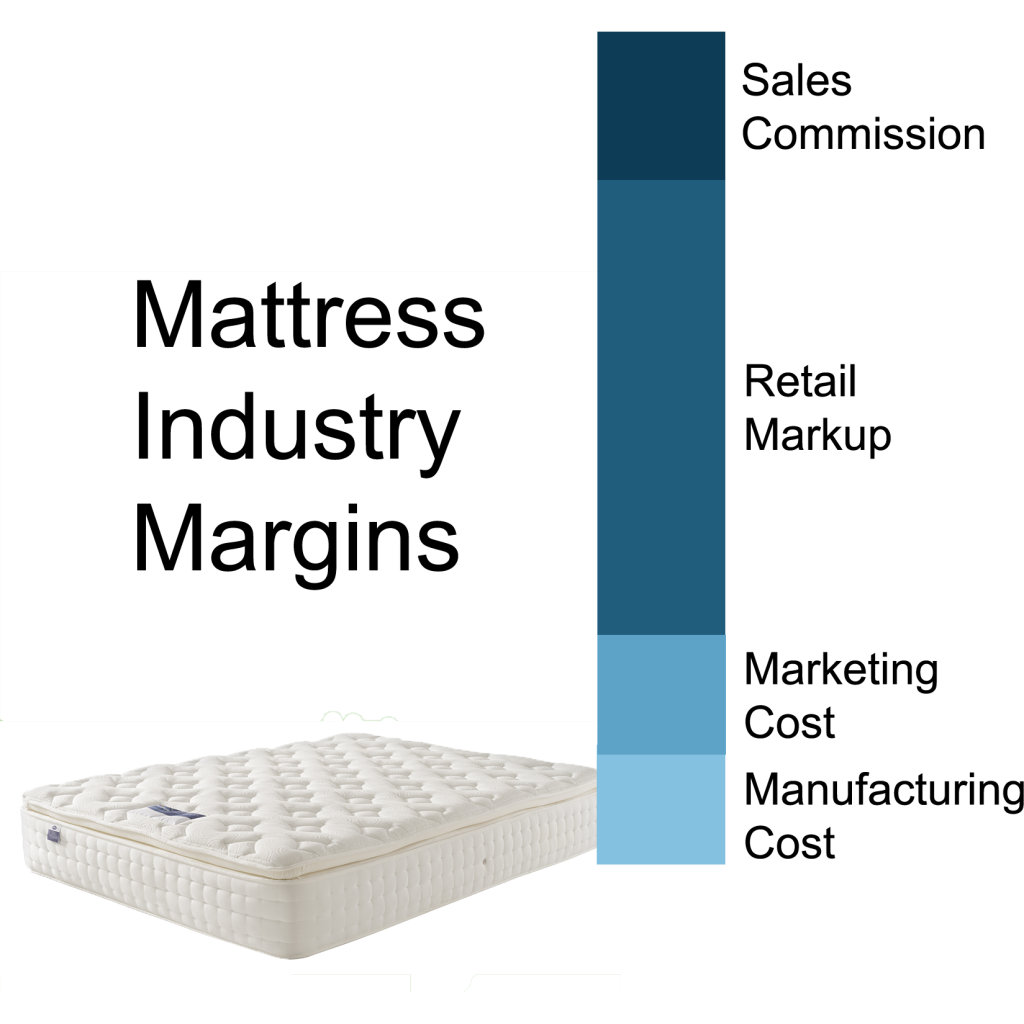If you’ve been shopping for a mattress recently, you’ve likely experienced some sticker shock. Mattresses will regularly sell for as cheap as $150 and as expensive as $8,000 – and to many it’s difficult to see what the additional dollars are really getting you in terms of a better sleeping experience.
Unfortunately, in many cases the answer is – nothing. Mattresses have tremendous markups, often 6-15 times the manufacturing cost. That means you might be paying $5,000 for a mattress that costs $300 to make.
So what about this industry results in such a tremendous markup for consumers?
We have an oligopoly on our hands. The mattress industry is dominated by just a few players. Sealy, Serta, Simmons, and Tempur-Pedic account for ~60% of all revenue for the industry. The top 15 companies make up ~80% of all revenue. That means that if these players are aligned in their margins, the consumer has little option but to be taken in by the game their playing.
The question is, what are these players doing that’s “justifying” such ridiculous markups?
1. Spreading misinformation by naming the same product different things
A mattress company will take the exact same product, and slap a different name/label on it for each mattress retailer. That means if you go to Sleepy’s, then to Mattress Firm, you will see the same mattress, but you won’t know it. That makes it very difficult for anyone but a true mattress expert to compare prices. As an added bonus, all the retailers can claim to match prices with competitors for a specific mattress – because no one else is selling that mattress. Pretty clever.
2. Selling through retailers, also taking a huge cut
Most mattresses are sold through retailers – who also take their cut. Not to mention the hefty commission that the salesperson will take with each mattress (don’t get me started on how this commission incentivizes a salesperson to sell you the most profitable mattress, not the best mattress for you). Yes there is cost to have the space, inventory, and keep the lights on, but it’s also another separate player looking to make big bucks. And they often do.
3. Adding features that sound great – but who knows?
Want a gel-infused mattress? Add some extra coils? European pillow top? An extra few inches of foam? Dunlop processing instead of Talalay? Most people have no idea what this means, and everything sounds great. Plus, everything feels great in the showroom – you really have to screw a mattress up to make it feel bad while someone lays on it for 5 minutes after they’ve probably been sleeping on a mediocre mattress for years. Having a bunch of features that no one really understands is great for a good salesman. And unfortunately, these features often don’t really result in an improved sleep experience. Just another reason to add some additional margin onto the sale.
4. Lack of consumer knowledge
Consumers only buy a mattress once every 5-10 years, and it’s a product that is difficult to really gauge the quality of a specific brand, since people have different sleep preferences and expectations. And since really your only point of contact is your local salesman, you don’t have a great opportunity to learn more. With no reference point, how can one know if they’re getting a good deal, or even getting a mattress that addresses their needs?
5. Lack of experience negotiating
Generally in the US, we rarely negotiate. We’ll negotiate for cars and mattresses, but really that’s about it. Thus people may be uncomfortable with the process, and feel like they’ve gotten a deal, even when they haven’t. A mattress salesman may (for example) knock off the sales tax, though we now know with the huge margin of the product, he could knock off plenty more and still make a reasonable commission.
People have always dreaded the mattress buying experience, and finally some companies are entering the mattress market to sell directly to consumers online – adding more transparency to the process and cutting out some of the middle men. Companies like Saatva, Casper, Tuft & Needle, and Leesa are starting to really shake up the traditional model. On Slumber Sage, we suggest you start by looking at the online mattress companies first to improve your overall experience and get a better deal than the large mattress companies will offer you.
 Slumber Sage Mattress Reviews and Sleep Tips
Slumber Sage Mattress Reviews and Sleep Tips
